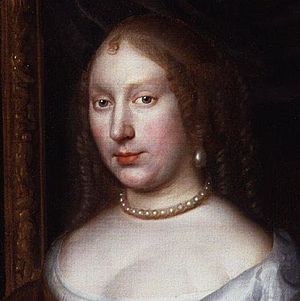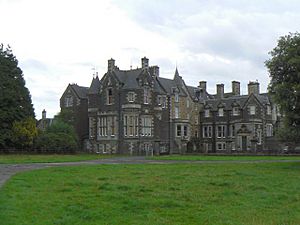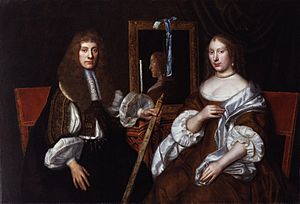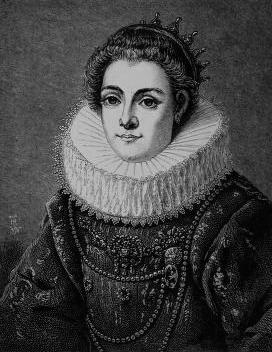Anna Mackenzie facts for kids
Quick facts for kids
Anna Mackenzie
|
|
|---|---|

Lady Mackenzie, countess of Balcarres and afterwards of Argyll
|
|
| Born | uncertain. his first biographer, in 19th century estimated 1621, which is incorrect as her brother was Christianized in Sep 1621, and Childs were Christianized in the first months of their life. Brahan Castle, Easter Ross, Scotland
|
| Died | 1707 (aged 85–86) |
| Nationality | Scottish |
| Political party | Jacobite |
Lady Anna Mackenzie (1621–1707) was a brave and clever Scottish noblewoman. She was also known as Ann MacKenzie. Anna was the wife of the first Earl of Balcarres. She was also the mother of the second and third Earls. After her first husband passed away, she married Archibald Campbell, 9th Earl of Argyll.
Anna even worked as a governess for William III when he was a child. She faced many challenges because she supported the Jacobite cause. Her second husband was executed for leading a rebellion. This rebellion was meant to help another uprising called the Monmouth Rebellion. Despite these tough times, Anna worked hard to protect her family's lands, the Balcarres estates. Her life story was written down and published long after she died.
Contents
Early Life and First Marriage
Anna Mackenzie was born around 1621 at Brahan Castle in Scotland. Her parents were Colin Mackenzie, the first Earl of Seaforth, and Margaret Seton. Anna had several brothers and sisters, but most of them died young. Only her older sister, Jean, lived to be an adult. Anna's parents both died when she was still a child.
After her father's death in 1633, Anna lived at Leslie House. This was the home of her cousin, Lord Rothes. In April 1640, Anna married another cousin, Alexander Lindsay. This marriage happened against the wishes of her uncle, who was then the head of her family. Alexander became Lord Balcarres the next year. Anna spent her life trying to keep the Balcarres estates safe. This was very difficult because of the troubled times and her family's support for the Jacobite cause.
Supporting the King
In 1647, Anna's husband became responsible for Edinburgh Castle. In 1651, Charles II became the King of Scots. He gave Anna's husband the title of Earl of Balcarres. On February 22, 1651, King Charles II visited the couple. This was just before Anna's first child was born, and the King became the baby's godfather.
After the Battle of Worcester, Anna and her husband went to the Scottish Highlands. Her husband was in charge of the royalist forces there. To help pay for the debts her husband had from supporting the king, Anna sold her jewelry and other valuable items. Many years of her life were spent trying to fix the financial problems the Balcarres family faced.
Their support for the king caused their lands to be taken away. Her husband tried to start a rebellion in Scotland. But in 1654, they were both called to France to help the king. Anna left her own children in Scotland. In 1657, she was chosen to be the governess for the young William III of England in the Hague. Anna, her husband, and their friends like John Maitland, 1st Duke of Lauderdale were very close.
After her husband died in the Hague on August 30, 1659, their young son, Charles (1650–1662), became the Earl.
Financial Struggles and Recovery
Anna returned to Fifeshire, Scotland, but soon went to France. She was a Presbyterian and helped get support from French Protestant ministers for the king in 1660. When the king returned to power in 1660, called the Restoration, he promised Anna a pension. He admired her greatly, but it took several years for the money to be paid. During this time, Anna and her children faced great hardship.
She stayed in England until May 1662. There, she met Richard Baxter, a famous preacher. He said that Anna's "great wisdom, modesty, piety, and sincerity made her accounted the saint at the court." Anna was very sad when her oldest daughter became a nun and later died in a nunnery. In 1662, Anna returned to Scotland. She became ill from poverty and worry. The King agreed to pay Anna and her older son £1000 a year. This was to thank them for their family's help. However, they had to give up the governorship of Edinburgh Castle in return.
Her son Charles died in October 1662. Then, her younger son, Colin, became the 3rd Earl of Balcarres. In 1664, Anna's financial situation improved when her promised pension was finally paid. She had asked for it in November 1663. The next few years were spent trying to pay off the debts on the Balcarres estates. In 1669, her son's rights to the Seaforth estates were given up for a large sum of money.
Countess of Argyll
On January 28, 1670, Anna married Archibald Campbell, 9th Earl of Argyll. After this marriage, she was able to help her son, Colin, with the debts he inherited from her first husband. However, her son did not make the most of this financial help.
Her second marriage also faced difficulties. Her husband was accused of serious crimes against the government. He managed to escape to Holland thanks to Anna's brave daughter, Sophia Lindsay. Sophia helped him get away disguised as one of her servants. It was said that Sophia avoided punishment only because the future James II spoke up for her.
Even though her husband's lands were taken, Anna later received financial support from the King. Her husband supported the Monmouth rebellion by starting a rebellion in Scotland. This was meant to work with the forces in England led by the Duke of Monmouth. Anna was arrested as soon as her husband arrived in Scotland to start the rebellion. She was held in Edinburgh Castle. Argyll was eventually executed, just as his father had been before him. After her husband's death, his son Charles married Anna's daughter, Sophia Lindsay, who had saved his life.
Anna was buried next to her first husband and their son Charles in the Balcarres chapel. Her memories and life story were collected and published in 1868 by Alexander Crawford Lindsay, the 25th Earl of Crawford.
Images for kids






